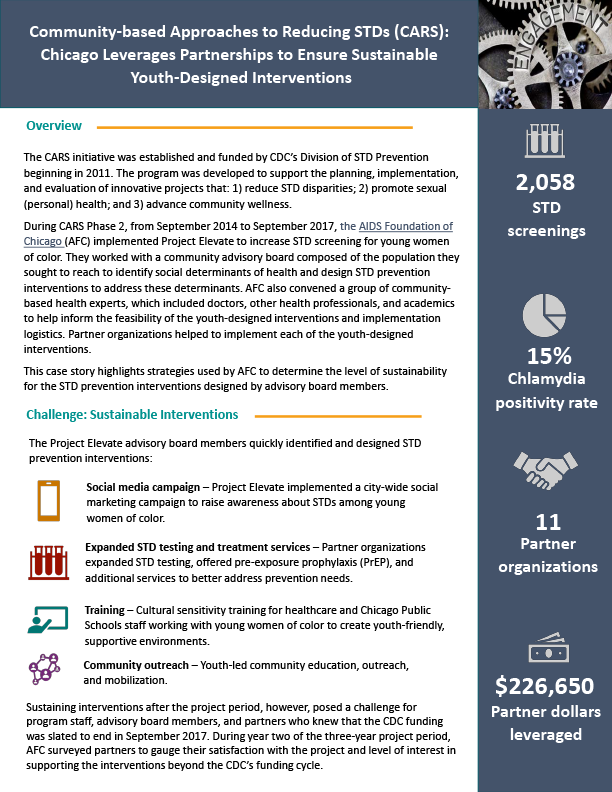Community-based Approaches to Reducing STDs (CARS):
Chicago Partnerships Sustain Youth Programs
The CARS initiative was established and funded by CDC’s Division of STD Prevention beginning in 2011. The program was developed to support the planning, implementation, and evaluation of innovative projects that:
- reduce STD disparities;
- promote sexual (personal) health; and
- advance community wellness.
During CARS Phase 2, from September 2014 to September 2017, the AIDS Foundation of Chicago external icon(AFC) implemented Project Elevate to increase STD screening for young women of color. They worked with a community advisory board composed of the population they sought to reach to identify social determinants of health and design STD prevention interventions to address these determinants. AFC also convened a group of community-based health experts, which included doctors, other health professionals, and academics to help inform the feasibility of the youth-designed interventions and implementation logistics. Partner organizations helped to implement each of the youth-designed interventions.
This case story highlights strategies used by AFC to determine the level of sustainability for the STD prevention interventions designed by advisory board members.

vials solid icon
2,058 STD screenings
chart pie solid icon
15% chlamydia positivity rate
people arrows solid icon
11 Partner organizations
money icon
$226,650 Partner dollars leveraged
The Project Elevate advisory board members quickly identified and designed STD prevention interventions:
device icon Social media campaign – Project Elevate implemented a city-wide social marketing campaign to raise awareness about STDs among young women of color.
vials icon Expanded STD testing and treatment services – Partner organizations expanded STD testing, offered pre-exposure prophylaxis (PrEP), and additional services to better address prevention needs.
chalkboard teacher solid icon Training – Cultural sensitivity training for healthcare and Chicago Public Schools staff working with young women of color to create youth-friendly, supportive environments.
users solid icon Community outreach – Youth-led community education, outreach, and mobilization.
Sustaining interventions after the project period, however, posed a challenge for program staff, advisory board members, and partners who knew that the CDC funding was slated to end in September 2017. During year two of the three-year project period, AFC surveyed partners to gauge their satisfaction with the project and level of interest in supporting the interventions beyond the CDC’s funding cycle.
During year two of the three-year project period, AFC outlined and implemented a sustainability planning strategy to assess whether the interventions were sustainable beyond CDC funding. The eight-step process addressed the following:
Step 1. What is the purpose of the program?
Step 2. Do advisory board members and stakeholders know the purpose of the program?
- List Highlights
Step 3. What has our program done?
- List Accomplishments and Achievements
Step 4. What publicity has our program received?
- Social Marketing Campaigns
- Events
- Articles
Step 5. How is the program structured?
- Community Participatory Project
- Meetings
- Agendas
- Policies
Step 6: What are the staffing resources?
- Funding for Staff
- Interns
- AmeriCorps
Step 7. What are the challenges and barriers for program implementation?
Step 8. Have we budgeted enough to cover our expected costs now and in the future?
- Apply for Similar Funding Opportunities
- Program Expansion
lite icon
Partner leverage – In order to successfully leverage partner resources, it is important to clearly delineate partner roles and contributions.
lite icon
Sustainability planning – Ensuring sustainability of interventions should start early and be considered during intervention development. Partners play a major role and should be involved in sustainability planning.
lite icon
Communication and evaluation – Communication is necessary to a strong evaluation. Involving partner organizations in the routine data collection and review is crucial to buy-in and evaluation use.
As a result of the Project Elevate youth-designed interventions, 2,058 STD screenings were conducted. The chlamydia positivity rate was 15 percent and the gonorrhea positivity rate was four percent.
AFC’s sustainability analysis of Project Elevate’s interventions found that they would be able to continue their interventions, most in a new capacity or at a smaller scale. They received funding from a new source that allowed them to keep the advisory board functioning in a new way to inform the new initiative to address stigma for women of color living with HIV. AFC also leveraged $226,650 partner dollars throughout the project. Structural interventions are still in place to-date.
- Social media campaign – The advisory board has been sustained and is now called the Learning Exchange Circle. Social media is still being used in Chicago Public Schools.
- Expanded STD testing and treatment services – Partner organizations have continued to offer STD testing, PrEP, and other services to better address the needs of young women of color.
- Training – Cultural competency training modules are still being used in Chicago Public Schools. To increase awareness of STDs and HIV, they have also continued the use of STD prevention videos.
- Community outreach – The advisory board continues to work with young women to reduce STD/HIV infections, focusing mostly on domestic partner violence, homelessness, and previously incarcerated women.
For more information about the CARS initiative, please visit https://www.cdc.gov/std/health-disparities/cars.htm
